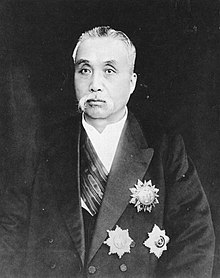
Back شو شيتشانغ Arabic Xu Shichang German Xu Shichang Spanish شو شی چانگ Persian Xu Shichang Finnish Xu Shichang French שו שה-צ'אנג HE Xu Shichang ID Xu Shichang Italian 徐世昌 Japanese
This article needs additional citations for verification. (June 2016) |
Xu Shichang | |||||||||||||||||||||||||||||||||||||||||||||||||
|---|---|---|---|---|---|---|---|---|---|---|---|---|---|---|---|---|---|---|---|---|---|---|---|---|---|---|---|---|---|---|---|---|---|---|---|---|---|---|---|---|---|---|---|---|---|---|---|---|---|
徐世昌 | |||||||||||||||||||||||||||||||||||||||||||||||||
 | |||||||||||||||||||||||||||||||||||||||||||||||||
| President of the Republic of China | |||||||||||||||||||||||||||||||||||||||||||||||||
| In office 10 October 1918 – 2 June 1922 | |||||||||||||||||||||||||||||||||||||||||||||||||
| Premier | Qian Nengxun Gong Xinzhan (acting) Jin Yunpeng Yan Huiqing (acting) Sa Zhenbing (acting) Liang Shiyi Zhou Ziqi (acting) | ||||||||||||||||||||||||||||||||||||||||||||||||
| Preceded by | Feng Guozhang | ||||||||||||||||||||||||||||||||||||||||||||||||
| Succeeded by | Zhou Ziqi | ||||||||||||||||||||||||||||||||||||||||||||||||
| Premier of the Republic of China | |||||||||||||||||||||||||||||||||||||||||||||||||
| In office 22 March – 23 April 1916 | |||||||||||||||||||||||||||||||||||||||||||||||||
| President | Yuan Shikai | ||||||||||||||||||||||||||||||||||||||||||||||||
| Preceded by | Lu Zhengxiang (as Prime Minister of the Empire of China) | ||||||||||||||||||||||||||||||||||||||||||||||||
| Succeeded by | Duan Qirui | ||||||||||||||||||||||||||||||||||||||||||||||||
| In office 1 May 1914 – 22 December 1915 | |||||||||||||||||||||||||||||||||||||||||||||||||
| President | Yuan Shikai | ||||||||||||||||||||||||||||||||||||||||||||||||
| Preceded by | Sun Baoqi (acting) | ||||||||||||||||||||||||||||||||||||||||||||||||
| Succeeded by | Lu Zhengxiang (as Prime Minister of the Empire of China) | ||||||||||||||||||||||||||||||||||||||||||||||||
| |||||||||||||||||||||||||||||||||||||||||||||||||
| Personal details | |||||||||||||||||||||||||||||||||||||||||||||||||
| Born | 20 October 1855 Weihui, Henan, Qing Dynasty | ||||||||||||||||||||||||||||||||||||||||||||||||
| Died | 5 June 1939 (aged 83) Tianjin, Republic of China | ||||||||||||||||||||||||||||||||||||||||||||||||
| Education | jinshi degree in Imperial examination (1886) | ||||||||||||||||||||||||||||||||||||||||||||||||
| Signature | |||||||||||||||||||||||||||||||||||||||||||||||||
Xu Shichang (Hsu Shih-chang; Chinese: 徐世昌; pinyin: Xú Shìchāng; Wade–Giles: Hsü2 Shih4-ch'ang1; courtesy name: Juren (Chu-jen; 菊人); October 20, 1855 – June 5, 1939) was a Chinese politician who served as the President of the Republic of China, in Beijing, from 10 October 1918 to 2 June 1922. The only permanent president of the Beiyang government to be a civilian, his presidency was also the longest of the Warlord Era. Previously, he was Minister of the Cabinet of the Imperial Cabinet during the Qing Dynasty.